All tried and tested on a Finesse! From the inexpensive to the rather less inexpensive- gadgets to treat your boat (or for someone else to treat you!) Wallets at the ready…
Thermometer and humidity meter Available unmounted from www.weather-station-products.co.uk, these meters are useful, attractive, very affordable and (I believe) German-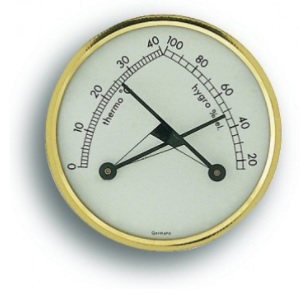 made. 70 mm diameter. We have used one for several years and it remains accurate. The humidity gauge shows a comfort range for humans. If the humidity exceeds this range, you risk condensation, mould and damp misery. If it remains below the range for any length of time you will see the shakes in your cabin sides opening up a treat.
made. 70 mm diameter. We have used one for several years and it remains accurate. The humidity gauge shows a comfort range for humans. If the humidity exceeds this range, you risk condensation, mould and damp misery. If it remains below the range for any length of time you will see the shakes in your cabin sides opening up a treat.
£10
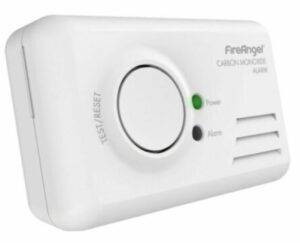 Carbon Monoxide sensor There are several evolving technologies for ‘smoke’ alarms (ionisation, heat, optical) and it’s tricky to choose something that won’t go off when you make the dinner on a boat. But there’s no argument about carbon monoxide. CO doesn’t explode like LPG and it doesn’t smell- but it impairs your judgement and can induce a coma and kill you. If you have any combustion on board you should have a CO sensor. Since carbon monoxide is slightly less dense than air and will rise given time, an alarm should be placed high up. From eBay; go for a make you have heard of, like Fire Angel. This one is a CO-9B, but whichever you go for it should conform to BS EN 50291-2 and have a BSI kite mark. Incidentally, we used to have our alarm sound sometimes when motoring on a still day- my guess is that exhaust gases can circulate back into the cockpit as the air flows at increased speed over the deck, creating a slightly lower pressure. Or maybe not.
Carbon Monoxide sensor There are several evolving technologies for ‘smoke’ alarms (ionisation, heat, optical) and it’s tricky to choose something that won’t go off when you make the dinner on a boat. But there’s no argument about carbon monoxide. CO doesn’t explode like LPG and it doesn’t smell- but it impairs your judgement and can induce a coma and kill you. If you have any combustion on board you should have a CO sensor. Since carbon monoxide is slightly less dense than air and will rise given time, an alarm should be placed high up. From eBay; go for a make you have heard of, like Fire Angel. This one is a CO-9B, but whichever you go for it should conform to BS EN 50291-2 and have a BSI kite mark. Incidentally, we used to have our alarm sound sometimes when motoring on a still day- my guess is that exhaust gases can circulate back into the cockpit as the air flows at increased speed over the deck, creating a slightly lower pressure. Or maybe not.
£14
(More information about CO alarms may be found at: https://www.boatsafetyscheme.org/media/294453/boat-co-alarms-may-18.pdf)
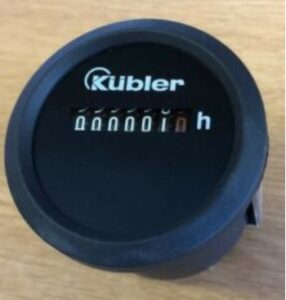 Hours run meter available in various formats and from various suppliers; this one was on eBay. A boat engine is maintained according to hours run; for example, our Yanmar diesel requires an oil change every 100 hours. Connect a meter to the supply made live by your ‘ignition’ key (which probably activates your rev counter and other engine gauges if they exist) and it will count the hours until you switch off again. You can mount it anywhere convenient inside the boat.
Hours run meter available in various formats and from various suppliers; this one was on eBay. A boat engine is maintained according to hours run; for example, our Yanmar diesel requires an oil change every 100 hours. Connect a meter to the supply made live by your ‘ignition’ key (which probably activates your rev counter and other engine gauges if they exist) and it will count the hours until you switch off again. You can mount it anywhere convenient inside the boat.
£22
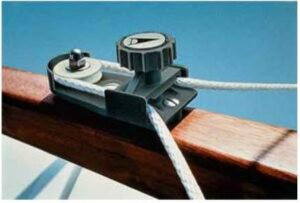 Davis Tiller Tamer The arrangement on a Finesse of the tiller over the lazarette allows for an easy installation of this helping hand. You will need two side entry clam cleats (CL218) or similar, screwed or bolted to the lazarette deck, to secure the two ends of a line that passes under the clamp. Very handy for locking the tiller for short periods of time or for stiffening the tiller action. Available from Marinestore (https://marinestore.co.uk).
Davis Tiller Tamer The arrangement on a Finesse of the tiller over the lazarette allows for an easy installation of this helping hand. You will need two side entry clam cleats (CL218) or similar, screwed or bolted to the lazarette deck, to secure the two ends of a line that passes under the clamp. Very handy for locking the tiller for short periods of time or for stiffening the tiller action. Available from Marinestore (https://marinestore.co.uk).
£37
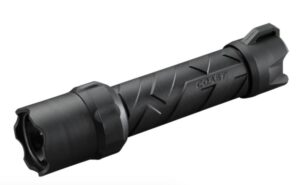 Coast ‘Polysteel’ torch, available from Force4 (www.force4.co.uk) in various sizes and with commensurate prices. You need a torch that you can drop, immerse, hold in your teeth and rely on. This example is the PS600 which is waterproof (of course), has 3 levels of brightness, has a beam that you can focus, and can throw a light over 200m. You can probably throw the torch that far and it should still work. Lifetime guarantee.
Coast ‘Polysteel’ torch, available from Force4 (www.force4.co.uk) in various sizes and with commensurate prices. You need a torch that you can drop, immerse, hold in your teeth and rely on. This example is the PS600 which is waterproof (of course), has 3 levels of brightness, has a beam that you can focus, and can throw a light over 200m. You can probably throw the torch that far and it should still work. Lifetime guarantee.
£38
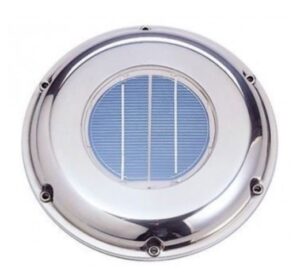 Ventilation solar fan When we acquired Lady Christina (or she acquired us) she had a couple of venerable old solar fans already installed. I tried to track another down to place in the foredeck over the berths, and only found an inferior product. When that failed prematurely I found this much better product, one that resembled the originals. Available from SeaFlo (www.seaflo-uk.com) it comes with a switch on the end of a long cable, should you wish to turn it off, but it is in fact extremely quiet. It comes with a choice of intake or extract fans; I always think that you should use them to extract, whether it be in the galley, the heads or the sleeping quarters.
Ventilation solar fan When we acquired Lady Christina (or she acquired us) she had a couple of venerable old solar fans already installed. I tried to track another down to place in the foredeck over the berths, and only found an inferior product. When that failed prematurely I found this much better product, one that resembled the originals. Available from SeaFlo (www.seaflo-uk.com) it comes with a switch on the end of a long cable, should you wish to turn it off, but it is in fact extremely quiet. It comes with a choice of intake or extract fans; I always think that you should use them to extract, whether it be in the galley, the heads or the sleeping quarters.
£51.
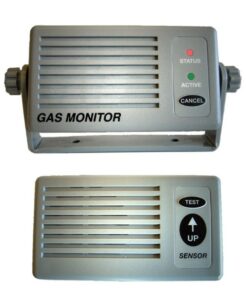 Gas monitor from NASA Marine. This comprises a monitor (mount anywhere) and a sensor which you mount as low as you dare- not low enough to be immersed by a rising tide in the bilges. It looks for traces of Calor, CampinGaz or whatever LPG product you burn onboard and produces a heart-stopping siren noise if the concentration reaches 10% of the lowest explosive limit. The cheapest on the market. Bad part: if the sensor gets wet, it can go off randomly when you least expect it. Good part: the aftersales service is amazing and you are dealing with the UK-based manufacturer direct.
Gas monitor from NASA Marine. This comprises a monitor (mount anywhere) and a sensor which you mount as low as you dare- not low enough to be immersed by a rising tide in the bilges. It looks for traces of Calor, CampinGaz or whatever LPG product you burn onboard and produces a heart-stopping siren noise if the concentration reaches 10% of the lowest explosive limit. The cheapest on the market. Bad part: if the sensor gets wet, it can go off randomly when you least expect it. Good part: the aftersales service is amazing and you are dealing with the UK-based manufacturer direct.
£83
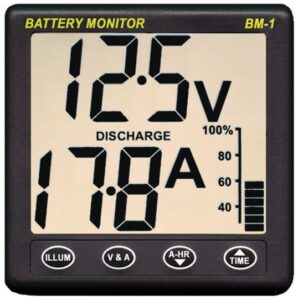 Battery Monitor from NASA Marine (Clipper variety). A reasonably easy gadget to fit, in series with the main domestic battery feed. It can monitor amps in and out as well as battery voltage, and can show an estimate of remaining hours. If you have a separate starter battery, it can show the volts over that too. The display is large and clear and the unit has back illumination in case you get curious after dark. Note that the connections need to be super clean and tight for an accurate reading. The draw of low-current devices that are left on continuously (for example bilge pumps on stand-by) can be nulled out so that the display shows zero when all other functions are off.
Battery Monitor from NASA Marine (Clipper variety). A reasonably easy gadget to fit, in series with the main domestic battery feed. It can monitor amps in and out as well as battery voltage, and can show an estimate of remaining hours. If you have a separate starter battery, it can show the volts over that too. The display is large and clear and the unit has back illumination in case you get curious after dark. Note that the connections need to be super clean and tight for an accurate reading. The draw of low-current devices that are left on continuously (for example bilge pumps on stand-by) can be nulled out so that the display shows zero when all other functions are off.
£110.
NB. The Clipper range also includes a speed-over-ground meter at £86 (requires an NMEA 0183 input from a GPS sender) which does not require drilling holes in your hull. They also do a new, electromagnetic speed-over-water system at £229 and a paddle wheel system at £163 but both require holes in the hull. And if that is your thing, they can sell you a very useful Clipper depth gauge for £163. This is £40 more than their Cruiser offering, but the latter does not allow for negative offset so you can’t simply display the depth of water from the surface.
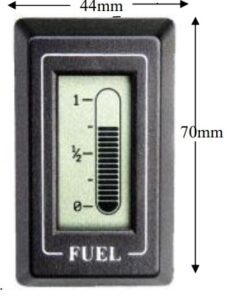 Diesel fuel gauge from MCS Boat Products (http://mcsboatproducts.co.uk/). MCS offer three versions of the sender transducer; the least disruptive to fit is Option 2, which measures the head of fuel above the transducer, which is designed to insert into a 1/4” BSP female thread. We had ours fitted into a junction on the fuel pipe at the exit of the tank. The gauge can be fitted anywhere convenient inside the boat. This unit draws a very small current and can be left on continuously. If you run your auxiliary engine a good bit, this gadget will bring you peace of mind and an instant appraisal of your remaining fuel without opening the tank and dipping. Accurate and reliable- we also use it to monitor tank filling to prevent an overflow.
Diesel fuel gauge from MCS Boat Products (http://mcsboatproducts.co.uk/). MCS offer three versions of the sender transducer; the least disruptive to fit is Option 2, which measures the head of fuel above the transducer, which is designed to insert into a 1/4” BSP female thread. We had ours fitted into a junction on the fuel pipe at the exit of the tank. The gauge can be fitted anywhere convenient inside the boat. This unit draws a very small current and can be left on continuously. If you run your auxiliary engine a good bit, this gadget will bring you peace of mind and an instant appraisal of your remaining fuel without opening the tank and dipping. Accurate and reliable- we also use it to monitor tank filling to prevent an overflow.
£119
 Folding boarding ladder from Marine Scene (www.marinescene.co.uk). If you have ever been in the water, intentionally or unintentionally, and tried to get back on board a Finesse, you will be glad you fitted the longest solid ladder on the transom that you could get hold of (or sorry that you didn’t). This one is a 2+3 (2 steps attached to the transom and 3 that hinge down, giving a deployed length of 1325mm overall (1102mm folded). No, it doesn’t trail in the water (Finesse 24) unless you are motoring hard; yes, when you are trying to get back on board you will be glad you got a ladder that reached well down into the water. It goes without saying that rope ladders are cheaper but are for acrobats only.
Folding boarding ladder from Marine Scene (www.marinescene.co.uk). If you have ever been in the water, intentionally or unintentionally, and tried to get back on board a Finesse, you will be glad you fitted the longest solid ladder on the transom that you could get hold of (or sorry that you didn’t). This one is a 2+3 (2 steps attached to the transom and 3 that hinge down, giving a deployed length of 1325mm overall (1102mm folded). No, it doesn’t trail in the water (Finesse 24) unless you are motoring hard; yes, when you are trying to get back on board you will be glad you got a ladder that reached well down into the water. It goes without saying that rope ladders are cheaper but are for acrobats only.
£120.
Chartplotter software Stentec Navigation sell highly detailed charts and provide 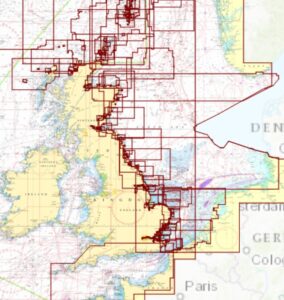 software to render them on any GPS-enabled device running Windows or Android operating systems. Their entry level software is free and is sufficient for using the charts to confirm your position to a high level of detail and precision, including buoyage, depths etc. (WinGPS 5 Lite for Windows, WinGPS Marine Lite for Android). Examples of charts include DKW ID10 English and Scottish East Coast, based on Imray; DKW UK1 which covers the huge area shown opposite (you get all of them in a bundle); and inland charts such as the whole of the Netherlands. Each chart bundle costs E130, although you can download their Friesland lakes chart for free to get an idea. Of course, you also have to add a GPS-enabled device; the easiest option would be a tablet, together with a holder to secure to the cabin side. We have ours parked under the port deck, easily swinging out over the ‘chart table’ when in use.
software to render them on any GPS-enabled device running Windows or Android operating systems. Their entry level software is free and is sufficient for using the charts to confirm your position to a high level of detail and precision, including buoyage, depths etc. (WinGPS 5 Lite for Windows, WinGPS Marine Lite for Android). Examples of charts include DKW ID10 English and Scottish East Coast, based on Imray; DKW UK1 which covers the huge area shown opposite (you get all of them in a bundle); and inland charts such as the whole of the Netherlands. Each chart bundle costs E130, although you can download their Friesland lakes chart for free to get an idea. Of course, you also have to add a GPS-enabled device; the easiest option would be a tablet, together with a holder to secure to the cabin side. We have ours parked under the port deck, easily swinging out over the ‘chart table’ when in use.
130 Euro
 Air conditioning OK, actually a fan (and a hand spray bottle of water from the local DIY). If you have sweated out hot days on a mooring you may have found that a fan can make a big difference. If you want it to be quiet enough to run at night in your sleeping quarters, to be able to fold against the wall, be positionable and to have a timer to turn off after chosen intervals, you need a good one. This is one of the best- that’s why it’s one of the most expensive. Caframo Sirocco marine fan, 25cm diameter, less than 400mA draw flat out. From Force 4.
Air conditioning OK, actually a fan (and a hand spray bottle of water from the local DIY). If you have sweated out hot days on a mooring you may have found that a fan can make a big difference. If you want it to be quiet enough to run at night in your sleeping quarters, to be able to fold against the wall, be positionable and to have a timer to turn off after chosen intervals, you need a good one. This is one of the best- that’s why it’s one of the most expensive. Caframo Sirocco marine fan, 25cm diameter, less than 400mA draw flat out. From Force 4.
£158



Pingback: Keeping water out |